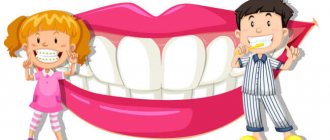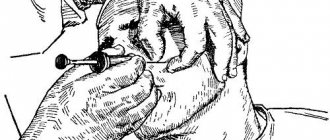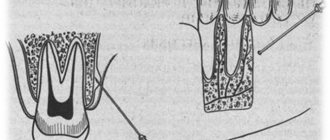Indications for local injection anesthesia
Most dental treatment is performed under local anesthesia.
It is mandatory to use:
- Removing a nerve from a tooth
- Gum operations – gum plastic surgery, deep periodontal cleaning – curettage and others.
- Installation of orthopedic structures on living teeth.
- Removal of any teeth and roots, as well as oral surgery
During minor interventions, such as the treatment of superficial caries, some patients can easily do without any anesthesia at all.
There are also types of treatments in dentistry for which anesthesia is not usually given, but there are people with increased sensitivity and a low pain threshold who may need it.
- Teeth cleaning by a hygienist
- Artistic restoration without preparation
- Making removable dentures - at the stage of taking impressions, anesthesia is sometimes given to people with an increased gag reflex
In pediatric dentistry, there is no need to rush with anesthesia - the sensitivity of the internal tooth tissue - dentin - is less pronounced in children than in adults. Therefore, first you need to try to prepare the tooth without an injection - and give anesthesia only at the request of the child. After all, many children are afraid of an injection more than anything else, and after it they may simply refuse to open their mouth again.
General anesthesia
General anesthesia is used in dentistry when it is necessary to carry out long-term interventions, for example, to remove several teeth or highly branched roots. This type of anesthesia is also necessary for dental phobia and severe gag reflex.
Administration of drugs for general sedation is possible in two ways: intravenously and inhalation (through a mask). In this case, the drugs used have a general effect on the body and all internal organs.
General anesthesia can cause complications:
- hallucinations and delusions;
- allergic reactions;
- respiratory dysfunction;
- vomit.
The risk of complications can be minimized by carefully studying contraindications to the use of general anesthesia. Anesthesia is used during complex dental procedures that require keeping the patient immobile and calm.
Contraindications to local injection anesthesia
- Allergic reactions to anesthetic
- Severe fear of dental treatment
- Mental disorders
- The child’s age is too young (usually under 3 years old)
- Lack of effect from drug administration
Non-injection anesthesia
Non-injection anesthesia involves the use of local agents that are in the form of an aerosol or gel. They are used for initial pain relief. In some cases where short-term dental treatment is required, non-injection sedation methods can be used as applications that are applied to a limited area of tissue.
Non-injection anesthesia in dentistry can be of the following types:
- electronarcosis;
- superficial or terminal anesthesia;
- refrigeration or freezing.
The specific type of anesthesia is selected by the dentist after a personal consultation, studying the patient's medical history, his general health and many other factors.
Particular attention when choosing an anesthesia option and a specific drug is required in the presence of chronic diseases affecting the cardiovascular system, kidneys, liver and respiratory organs. It is also important to minimize the risks of severe allergic reactions in people suffering from allergic pathologies (bronchial asthma, skin diseases).
Types of local anesthesia
- Application anesthesia
Typically, topical anesthesia is used as the first stage - its essence is that a lidocaine-based gel or liquid is applied to the mucous membrane, which penetrates well through the surface layers and causes numbness. Most often, thanks to it, they achieve dulling of sensitivity for a more painless injection.
Sometimes it can be used as an independent method of pain relief - for example, to remove a baby tooth that is supported only by a thin strip of gum.
Preparations for topical anesthesia are made with a pleasant smell and taste - this makes it easier for patients to accept the treatment.
- Infiltration anesthesia
Infiltration anesthesia is a type of local anesthesia that spreads to 2-3 adjacent teeth and is currently the most popular method of anesthesia.
During the injection, our doctor creates an anesthetic depot in the projection of the root of the tooth that is going to be treated. The anesthetic penetrates into the bone within a couple of minutes and blocks the transmission of nerve impulses in the injection area. If a single-rooted tooth is being treated, then one injection is given from the side of the cheek, but if the tooth is multi-rooted, an injection is often added from the palatal side.
This is why infiltration anesthesia is more effective on the upper jaw than on the lower jaw - the bone of the upper jaw is more spongy and allows the solution to pass through more easily.
This method of anesthesia is not recommended for purulent foci of inflammation - it is not effective enough in this environment and at the same time brings more pain. When treating purulent inflammations, it is better to use conduction anesthesia.
- Conduction anesthesia
Conduction anesthesia in dentistry is one of the most effective methods of anesthesia. With this option, it is not small nerve endings that are blocked, but larger nerve trunks. Due to this, it is not the area of 2-3 adjacent teeth that becomes numb, but half of the jaw and adjacent tissues.
Types of conduction anesthesia: palatal anesthesia, tuberal anesthesia, infraorbital anesthesia, incisive anesthesia - these are subtypes for the upper jaw.
For the lower jaw, conduction anesthesia is divided into: mental anesthesia, mandibular anesthesia and torus anesthesia.
- Intraosseous
It is most often used during extraction and involves administering an anesthetic under pressure directly into the bone tissue between the roots of the teeth. The effect of intraosseous anesthesia does not last long, since a very small amount of the drug is injected. But the action comes almost instantly.
- Intraligamentary
With this type of anesthesia, the drug is injected into the space between the tooth and the bone. Since there is little space there, a very small amount of anesthetic is injected, and the numbness will last up to half an hour. Thanks to this, you can treat several teeth at once in one visit.
- Intracanal anesthesia
When a nerve is removed, there is often residual pain even after intraligamentary anesthesia. Then our doctor injects the anesthetic directly into the nerve cavity - in this case, numbness occurs immediately and lasts quite a long time.
Local anesthesia in pediatric dentistry
Local anesthesia is not recommended for young children under 2-4 years of age. Even if it is possible to fraudulently persuade a child to take an injection, after it, as a rule, he will no longer open his mouth for further treatment. Up to 6-7 years of age, the optimal method is infiltration anesthesia (including for the treatment of lower teeth). At this age, the lower jaw is not yet so dense and there is no need for conduction anesthesia. Of the drugs for children, the optimal choice would be articaine with a low adrenaline content of 1:200000 - since long-term manipulations are still contraindicated for children (they quickly get tired of the treatment), there is no need for long-term pain relief for many hours.
Instruments for local anesthesia
At the moment, a carpule syringe is used to inject the anesthetic - this is a metal syringe, it can be used many times, it is sterilized in the same way as other dental instruments. A carpule with an anesthetic is inserted into the carpule syringe - a special glass cartridge, factory-made.
Currently, the Trilogy Medical and Dental Center uses carpule syringes for injection anesthesia - they are much more convenient and more sophisticated than conventional disposable syringes.
The thickness of the carpule syringe needle is only from 0.3 to 0.5 mm - thanks to this, the injection is much more painless than when using a conventional disposable syringe.
The needle is also very flexible and not brittle - thanks to this, the doctor can bend it at an angle convenient for himself and perform anesthesia even more accurately and conveniently for the patient.
Maxillary nerve block
Author: K. Bassett
A maxillary nerve block, also known as a second branch of the trigeminal nerve block, is indicated if there is a need to numb the half of the upper jaw. Its advantage is that pain relief for the entire half of the jaw is achieved through one injection, that is, there is no need to use several different techniques. This type of anesthesia is also convenient in case of inflammation in the area of other intended injection sites, when local anesthesia in this area may lead to further spread of infection or fail to provide the proper depth of pain relief (or both). Despite these benefits, there are significant risks and difficulties when performing a maxillary nerve block. It can be difficult to perform this type of anesthesia from the palatal approach, while placement from the tuberal approach is associated with the development of complications.
Routine use of maxillary nerve blocks on an ongoing basis is discouraged. It is recommended to begin studying and practicing it under the supervision of an experienced doctor who has performed this procedure many times.
There are three known techniques for blocking the maxillary nerve. The first is done from the vestibular approach and is known as the tubercular or maxillary nerve block via the tuberal/vestibular/buccal approach. The second technique uses a palatal approach and is known as a maxillary nerve block through the greater palatine foramen/pterygopalatine canal, or simply a palatal nerve block. The third technique is performed via an extraoral approach and will not be discussed in this text.
Pain relief area
Anesthesia occurs for structures innervated by the maxillary nerve: the pulp and periodontal tissue of all teeth, as well as the tissues of the palate to the middle of the upper jaw on the side of anesthesia. There is also anesthesia of facial tissues: upper lip and cheek, lower eyelid, lateral part of the nose. Tissue hemostasis requiring treatment does not develop with any of the approaches. All areas of anesthesia obtained during anesthesia of the anterior, middle alveolar nerve, infraorbital anesthesia, anesthesia at the greater palatine foramen and incisive anesthesia are included in the area of anesthesia during block of the maxillary nerve.
Anatomical factors
The branches of the maxillary nerve arise in the cranial cavity, the pterygopalatine fossa, the infraorbital canal and the facial tissues in the upper jaw. The last three exit through various foramina and canals and join the posterior branches of the maxillary nerve in the pterygopalatine fossa before its entry into the cranial cavity through the foramen rotunde. The trunk of the maxillary nerve is formed in the pterygopalatine fossa by the fusion of its branches, which are then joined by the meningeal branches from the dura mater. After this, the maxillary nerve becomes part of the trigeminal ganglion. The right and left maxillary nerves innervate the upper jaw and adjacent skin, nasal cavity, palate, maxillary sinuses, nasopharynx and part of the dura mater.
The maxillary artery is protected from masticatory pressure by the pterygoid venous plexus, which is emptied in response to compression, thus ensuring continuous blood flow through the artery (Fehrenbach &









